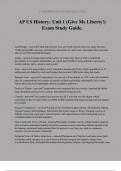©THEBRIGHTSTARS 2024/2025
AP US History: Unit 1 (Give Me Liberty!)
Exam Study Guide.
Land Bridge - answer✔A land link between Asia and North America that was intact between
15,000 and 60,000 years ago; most Native Americans are said to have descended from ancestors
who crossed this land link (Beringia)
Aztecs - answer✔A large-scale Indian society in modern-day Mexico with a centralized
government in its capital Tenochtitlan; its capital had 250,000 citizens and had royal palaces,
central markets, and a complex road system
Incas - answer✔A large Indian society centered in modern-day Peru; it had a population of 12
million and was linked by roads and bridges that stretched 2,000 miles along the Andes
Hernan Cortes - answer✔Conquistador who arrived at Tenochtitlan in 1519; with a few hundred
men, he conquered the city because of superior military technology, enlisting the aid of some
Native allies, but most importantly, disease (smallpox epidemic)
Francisco Pizarro - answer✔Conquistador who conquered the Inca society; captured the Indian
king, demanded and received a ransom, then killed the king anyway
Cahokia - answer✔City centered near present-day St. Louis that was the largest settled
community in the US until 1800; its 10,000-30,000 residents built giant mounds and was topped
by a temple
Iroquois Confederacy - answer✔A group of five Northeast Indian nations- the Mohawk, Oneida,
Cayuga, Seneca, and Onondaga- that formed the Great League of Peace, bringing a period of
stability to the area; each year a Great Council, with representatives from each group, met to
coordinate behavior towards outsiders
Native American Views of Land - answer✔Generally, in Indian society, village leaders assigned
plots of land to individual families to use for a season or more, and tribes claimed specific areas
for hunting; unclaimed land remained free for anyone to use; they saw land as a common
resource, not an economic commodity
European Views of Native Americans - answer✔Europeans saw Natives in extreme terms, both
as friendly, noble savages, or as uncivilized and brutal savages, but negative images soon
overshadowed; they concluded that Indians lacked genuine religion, worshipping false gods; they
, ©THEBRIGHTSTARS 2024/2025
said Indians didn't really "use" their land, thus having no claim to it; they saw Indians as weak
men and mistreated women, considering the men "unmanly"
Development of African Slavery - answer✔Slavery in Africa long predated the coming of
Europeans; African slaves tended to be criminals and debtors and had well-defined rights; the
coming of the Portuguese accelerated the buying and selling of slaves within Africa; over
100,000 went to Spain and Portugal from 1450-1500
Reconquista - answer✔The reconquest of Spain from the Moors (African Muslims) in 1492; was
completed during reign of King Ferdinand and Queen Isabella; to ensure religious unification,
they required all Muslims and Jews to either convert or leave the country
Ferdinand and Isabella - answer✔Their marriage in 1469 united the warring kingdoms of Aragon
and Castille; they agreed to become sponsors for Columbus's voyage
Christopher Columbus - answer✔Seasoned mariner who believed that by sailing west he could
quickly cross the Atlantic to Asia; underestimated Earth's size; arrived at the Bahamas, then
encountered Hispaniola; went back to Hispaniola and tried to create a settlement there, but
failed; made four voyages in all and went to the grave believing he found a westward route to
Asia, until Amerigo Vespucci disputed his claim after his death
Columbian Exchange - answer✔The transatlantic flow of goods and people that altered millions
of years of evolution; Europe was introduced to corn, tomatoes, potatoes, peanuts, tobacco and
cotton; the Americas were introduced to wheat, rice, sugarcane, horses, cattle, pigs, sheep, and
brand new germs and diseases
Encomienda System - answer✔System in which the first settles had been granted authority over
conquered Indian lands with the right to extract forced labor from the natives; was replaced in
1550 by the repartimiento system, in which natives were legally free and entitled to wages, but
were required to perform a fixed amount of labor each year
Mestizos - answer✔People of mixed origin; the offspring of a Spaniard and Indian; by 1600, they
made up a large part of the urban population of Spanish America and repopulated the Valley of
Mexico, where disease decimated the previous inhabitants
Pope Alexander VI - answer✔In 1493, to further legitimize Spain's claim to the New World, he
divided the non-Christian world between Spain and Portugal; Portugal got control of Brazil,
while Spain got pretty much the remainder of the Western hemisphere, which was stated in the
Treaty of Tordesillas
Juan Gines de Sepulveda - answer✔Spanish student of Aristotle who relied heavily on the
"barbarous' view of Indians; believed the Indians are inferior to the Spanish and that the Spanish
have a right to rule them; called them ferocious warmongers who were born into slavery; saw
them as very civilized and not totally lacking in reason, but said they should accept Christianity
fully




